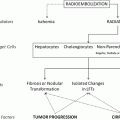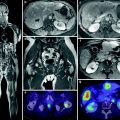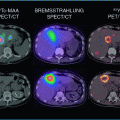Fig. 1
Potential points of integration of RE into the treatment pathway of patients with liver-only or liver-dominant unresectable colorectal liver metastases. The shaded box shows clinical trials testing RE with systemic therapy. CAPIRI capecitabine and irinotecan; CAPOX cetuximab, oxaliplatin and capecitabine; 5-FU 5-fluorouracil; FOLFIRI 5-fluorouracil, leucovorin and irinotecan; FOLFOX 5-fluorouracil, leucovorin and oxaliplatin; RE radioembolisation. An example of a patient registry in development is: http://www.sirtex.com/content.cfm?sec=usa&MenuID=1120&ID=F4CCC1C2
7.3 Choice of Radiosensitising Drug
A second consideration concerns which drug or combination of drugs should be given with RE for optimum radiosensitisation. It should be noted that, since the biological mechanism of radiosensitisation (as discussed above) may be independent of the mechanism of anti-cancer efficacy of the same drugs used without concomitant radiotherapy, there is a scientific rationale for using a radiosensitising chemotherapy drug that the patient has previously received and may even have previously shown “tumour resistance” too. Oxaliplatin, 5-FU and irinotecan are all radiosensitisers, and the selection of radiosensitising chemotherapy in clinical practice should be guided by the evidence-based dosing regimes which have been demonstrated to be safe with RE (Sharma et al. 2007; van Hazel et al. 2009; Hendlisz et al. 2010) rather than by the need to control microscopic or macroscopic disease outside the liver. Following the administration of radiosensitising chemotherapy with RE, the patient can subsequently receive a systemic regime which may offer further survival benefit.
7.4 Clinical Trials
Currently, insufficient evidence exists to recommend the routine addition of Yttrium-90 RE to systemic chemotherapy in the first-line setting. Patients who wish to receive RE as first-line therapy for their metastatic colorectal cancer, and who fulfil the inclusion criteria for the clinical trials, should participate in the SIRFLOX and FOXFIRE studies. These clinical trials are currently recruiting patients in the UK, Europe, Australia, New Zealand and the USA. Since over 500 patients have already been recruited to these studies, it is anticipated that recruitment to both studies will be completed by 2014 and survival data should be available in 2017.
7.5 Current Practice
The practice at several institutions at present is to offer oxaliplatin and 5-FU chemotherapy [in the dosing regime shown to be safe in Sharma et al. (2007)] with RE as second-line or subsequent line therapy for patients with liver-dominant or liver-only metastases from colorectal cancer, regardless of their previous chemotherapy history. In patients who have experienced unacceptable toxicity with oxaliplatin (e.g., persistent peripheral neuropathy), RE can be combined with infusional 5-FU (Hendlisz et al. 2010) or with irinotecan (van Hazel et al. 2009), again using the dosing regimes of chemotherapy which have been shown to be safe. Consistent with current clinical trials, current practice at many centres is to administer RE on day 2, 3 or 4 of cycle 1 and to administer 6 weeks of chemotherapy in total for radiosensitisation. Following 6 weeks of therapy from the date of RE, chemotherapy can be switched to an alternative systemic regime to optimally manage extrahepatic disease.
8 Conclusions
As the predominant cause of death in patients with advanced colorectal cancer, liver disease progression presents a major clinical challenge but also a therapeutic target. Within the context of limited extrahepatic disease, improved local control of liver metastases will offer survival benefit and therefore a better prognosis for such patients. Currently, the only potentially curative treatment modality for liver disease is surgical resection, which is only feasible in a minority of patients due to a number of constraints. However, combination of RE and systemic chemotherapy, which is not limited by the same constraints as surgery, has been shown to downstage a significant proportion of patients with initially unresectable disease, and thus convert them to candidates for potentially curative resection. The evidence base for combining RE and chemotherapy in the first-line treatment of metastatic colorectal cancer is robust enough for two large-scale phase III trials to be initiated to test the hypothesis that the greatest clinical benefit from RE may be achieved from this combination therapy at an early timepoint in a patient’s disease course. These randomised trials should provide high-quality evidence regarding whether this strategy improves the overall survival of patients with liver-dominant or liver-only unresectable liver metastases, and which subgroups of patients benefit most. In second-line and subsequent lines of therapy for metastatic colorectal cancer, we recommend that the combination of RE and systemic chemotherapy should be performed based on the principles of optimal intrinsic radiosensitisation of the liver metastases rather than by the concept of spatial cooperation, i.e. the need to control microscopic or macroscopic disease outside the liver. Following the administration of 6 weeks of radiosensitising chemotherapy with RE, patients can subsequently receive any systemic regime for further survival benefit.
Acknowledgments
RAS is funded by the Bobby Moore Fund of Cancer Research UK, the Higher Education Funding Council for England and the NIHR Biomedical Research Centre Oxford.
References
Blackstock AW et al (1999) 202 Oxaliplatin: in vitro evidence of its radiation sensitizing activity—preclinical observations relevant to clinical trials. Int J Radiat Oncol Biol Phys 45(3, Supplement 1):253–254
Bowel cancer incidence statistics (2009) Available from: http://www.cancerresearchuk.org/cancer-info/cancerstats/types/bowel/incidence/uk-bowel-cancer-incidence-statistics
Cancer Genome Atlas (2012) Comprehensive molecular characterization of human colon and rectal cancer. Nature 487(7407):330–337CrossRef
Chen AY et al (1997) Mammalian DNA topoisomerase I mediates the enhancement of radiation cytotoxicity by camptothecin derivatives. Cancer Res 57(8):1529–1536PubMed
Cosimelli M et al (2010) Multi-centre phase II clinical trial of yttrium-90 resin microspheres alone in unresectable, chemotherapy refractory colorectal liver metastases. Br J Cancer 103(3):324–331PubMedCentralPubMedCrossRef
Cunningham D et al (1998) Randomised trial of irinotecan plus supportive care versus supportive care alone after fluorouracil failure for patients with metastatic colorectal cancer. Lancet 352(9138):1413–1418PubMedCrossRef
Stay updated, free articles. Join our Telegram channel

Full access? Get Clinical Tree







